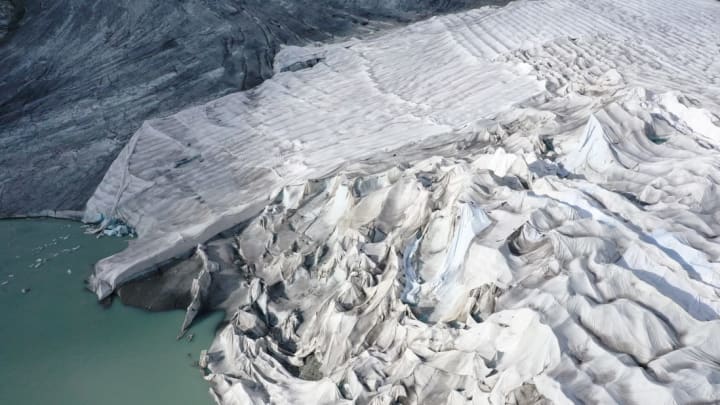With the balmy summer sun beating down on you, the last thing you’d want to do is bundle up in a thick, cozy blanket. For glaciers, it’s a little different. Every summer, a Swiss group swaths the Rhône glacier in enormous fleece blankets to block the sun from melting it.
Because the blankets are white, the glacier still looks relatively normal from afar. But the color wasn’t chosen for aesthetic purposes: As Live Science reports, white helps reflect light before it hits the ice. Though glaciologist David Volken told Agence France-Presse in 2015 that he believes the blankets could slow the damage by up to 70 percent, he also acknowledged that it’s a stall tactic, not a permanent solution—on a hot day, 3 to 5 inches of the glacier can still slip away.
For Switzerland, concern for the future of this particular glacier extends beyond its environmental implications. Beneath the grayish surface of the Rhône glacier lies an otherworldly, blue ice grotto which draws thousands of visitors each year. According to Switzerland’s national tourism website, the 330-foot-long tunnel is redrilled annually and has been a tourist attraction since 1870, when the Furka pass road made it easily accessible by foot.

Fleece blankets are just one innovative method scientists have proposed to combat glacial melt all over the world. As Atlas Obscura reports, John C. Moore, chief scientist at Beijing Normal University’s College of Global Change and Earth System Science, and his colleagues suggested separating a Greenland glacier from the warmer water that erodes its icy edges by creating a barrier of gravel and sand between them. Another idea was to simply vacuum away that water completely. Johannes Feldmann, a scientist at the Potsdam Institute for Climate Impact Research, and his team proposed fortifying the West Antarctic ice sheet by turning 8 trillion tons of ocean water into snow and blasting it onto the sheet. Founder and CEO of the nonprofit Ice911 Leslie Field’s project is similar to the ice blankets—she’s currently testing a reflective material made from microscopic glass balls that could keep ice cool beneath the sun.
While some people are working on temporary fixes, others are finding ways to honor the glaciers we’ve already lost to climate change—like this plaque for the Icelandic glacier Okjökull. Let’s hope the Rhône glacier doesn’t see the same end anytime soon.
[h/t Live Science]
